Archeology and Sustainable Regional Development with a Case Study- Juniper Publishers
Archaeology & Anthropology- Juniper Publishers
Abstract
The purpose of this research is to analyse some
characteristics of the archeological heritages and clarifies how they
used natural energies. This research is based on the problem-oriented
methodology and aims to introduce a new architectural model. The model
uses natural energies like ancient architecture, but with the help of
new building materials and technologies. The case study strategy of this
paper rests mainly on analyzing the elements of the ancient structural
systems and their functions related to the energy supply and
consumption. The case study of Sistan looks at the dependency of the
ancient construction to nature. The new construction model as a
modernized version of the ancient building is applicable everywhere.
Nevertheless, the model is more helpful for the underdevelopment
regions. The result of this research contributes to the cities/regions
to overcome the current crises, including provision of energy,
environmental degradation and the unsustainable urban development.
Keywords: Archeology; Ancient architecture; Natural resources; Wind room; Ventilation; Modernized version
Abbreviations: BEA: Building Environmental Assessment Technique; PPFA: Past Present Future Analysis; POM: Problem Oriented Method
Introduction
Major urban developers are worried about the energy
supply for the built environments. There are multiple construction
problems cause expensive and unsustainable energy usage. Factually, the
current development has been accused of producing excessive consumption
of global energy resources and polluting of the environment. The major
current development procedures are meeting less sustainable use of the
energy. The architectural heritage illustrates that those had been built
according to the local culture and livelihood. Talent architectures and
civil engineers have improved the structural systems and skeleton of
towns by learning from climates, nature, inhabitants’ needs and economic
requirements. For example, Hassan Fathi has done a lot in this regard
[1] . In the ancient civilizations, the architecture had been an
important element of the Iranian culture [2].
Iranian architecture not only had displayed a great
variety both structural and aesthetic, but also as Upham Pope wrote it
had included a wide range of applications [3]. The energy efficiency in
Iranian houses had also been a functional characteristic [4]. As the
ancient heritage proved, people had been using natural resources and
energies well. The purpose of this paper is to recommend the use of
natural energies in homes and cities. It aims to encourage the urban
managers and contractors to use a new school of architecture based on
the application of ancient architectural ideas, but with the help of new
technologies at this time. This research is both theoretical and
practical. In the theoretical perspective, it rests on theories of
vernacular architecture and earth-architecture.
The practice of this research is its field study.
This research applies a problem-oriented method and performs a past →
present → future analysis. It studies the ancient building techniques,
particularly Mede architecture in Sistan region. It adds the experiences
of ancient architecture to new information, building knowledge and
materials to solve the current regional/urban crises in terms of energy
and water supply. This paper designs a modernized version of Mede’s
homes to promote the pattern of nature-based construction. This research
understood the urgent problem of current urban development, which not
only does not rely on nature, but also destroys it. It argues that there
are rational socioeconomic and environmental reasons to learn from the
ancient nature-based architecture school. While the underdevelopment
communities left the nature-based socioeconomic regimes, the ever
expanding Urbanism degrades the environment and natural resources in the
regions [5].
At the same time, the new technologies have changed
the major general feature of the physical expansion of the cities,
economic activities and social life against the environment and nature.
Simultaneously, one result of the new information and technological
advances has been a sharp reduction rate of mortality in the
underdevelopment countries and the population increase. The current
trend requires many new homes and urban spaces from one side and it is
damaging the natural resources increasingly from the other side. In the
next parts, this study examines the validity of the following
hypothesis: The Sistan ancient architecture procedure together with new
knowledge, materials and technologies will solve the urban/regional
crises
and conserves natural resources.
Current Regional/Urban Development Problems
The current paradoxical problem is the expansion of cities
from one side and the need for various energies from another
side. Figure 1 reports a continuous dramatic population increase
during 1880-2010. The dramatic population rise in Iran has
religious and political roots [6]. Iran has also exhibited one of the
sharpest urban expansion rates in the world according to the UN
humanitarian information unit. Approximately 73.4 percent of
Iran’s populations are in urban areas [7]. This fact relates to the
widespread migration to the cities (The same source). Changes in
urbanization law and regulations convert the producer villages to
consumer cities. This process created more than 400 cities only
in the period of 1996-2005. Increasing of urbanization in the
recent decades left millions of poor people, who are not integrated
into the urban economies. They have been left without adequate
infrastructure, energy, water and occupation.

Ghobadian described the problem: “Continuous increase of
the population caused depletion of the water resources so that
we are disabling to settle our people” [8]. The new built environments
have been developed without regard to traditional livelihood,
lifestyle and culture [9]. Asadi argued convincingly, but the
cities have still more problems. Small neighborhoods have become
cities and cities are inside the protected walls. New rings of
walls have been added constricting the horizontal views of blue
skies. Beds of natural and seasonal rivers have become places for
vulnerable homes filled with waste and sewage. Urban difficulties
in arid and semi-arid regions of Iran are still more complicated. In
the regions, the urban areas faced climatic hardness, depletion of
natural resources and degradation of environmental components.
Consequently, the regional cities put stress on eroded soils and
show a thirsty earth with no plants.
Particularly, failures such expansion of unplanned and
unauthorized urban districts, need for urban infrastructure, lack
of public urban spaces, vulnerable and non-resistant buildings
against natural hazards, lack of technology and weak official
authorities are visual perspectives. Many scholars, i.e. Shahraki
introduce the climatic hardness as a crisis as well [10]. Worse, the
head of the National Security Council said that the water crisis
has become a security issue. As the scholars discuss, the climate
and social conflicts damaged the natural resources. This two facial
problem has been deepened by the distancing from nature and
has reached at a critical level now. When people left the traditional
lifestyle, they built their homes unsustainable. Most of them do
not have any relationship with nature since they supply fresh
air, light, and energy with the help of mechanical and electrical
devices. A solution to all the mentioned problems, including
the energy supplying, shall stand on infinite natural resources.
Therefore, the result of our theoretical and field studies suggests
an urban/regional development way that has a strong connection
with nature.
Methods Applied
Research Methodology
While this research uses both theory and practice, its
practical feature is heavier. It studies the relationship between
built environments and nature. For this reason, a problemoriented
method (POM) has been applied to study the harms of
not being friend with nature. Shahraki has introduced a problemoriented
method as a suitable tool to deal with the regional/
urban development crises in the underdevelopment regions [11].
The POM is pertinent to this work to look at the problems in none
nature-based built environments. As this research suggests the
usage of natural resources, a case study has been implemented to
analyze the energy efficiency in the ancient construction of Sistan
region. The case study analyzes and compares the advantages and
shortcomings of the ancient buildings.
It discusses the applicability of the Mede’s building techniques
to future constructions. This research compares Sistan
traditional homes that benefited natural energies to the contemporary
regional/urban developments. A building environmental assessment technique (BEA) has been performed during the process
of the past-present-future analysis (PPFA) as well. The POM,
BEA, PPFA and the case study provided necessary foundations for
building a nature-based model of a structural system. The systems
analysis and the systematic thinking in micro and macro dimensions
are other important procedures used in this research. The
components of the ancient building systems that influence the energy
efficiency have also been analyzed by this research.
A Nature-Based Development Method
The history of housing and the built environment is an exciting
and multifaceted story that reports socioeconomic conditions,
lifestyles, and building methods in various eras. Related to their
geographic place, local climate and socioeconomic ordering
people have built homes and other structures [12]. Scientists
understood many issues such as forms and plans of homes and
building materials with the help of the PPFA. Scholars, i.e. Gibbs
and O’Neill explored the history of built environments to adopt
green building methods and techniques in the United Kingdom
[13]. The history of architecture and building reports that the
human has come a long way since people first used natural energy
sources for their homes and fuels for their fires. The ancient
Chinese used concentrated solar power for heat energy and fire.
Native Americans used hot springs as renewable geothermal
sources for cooking and heating. Some historians speculate the
Egyptians used wind power to build their pyramids.
From Greece and Rome to Persia and North America, people
benefited of geothermal, water, wind, and solar power in the
ancient constructions [14]. Even today, you still see the ancient
Persian wind towers that use wind to cool and heat homes. You
also see ancient Roman gravity aqueducts for creating power,
ancient Jerusalem gray-water plumbing to reuse water, ancient
Roman thermal baths that could withdraw geothermal heat
energy and ancient Greek cities that used passive solar systems
for heating. You see the Native American cliff dwellings that used
passive solar shade for cooling as well. In all examples of the
ancient buildings, people had focused on the connection between
the buildings and nature. During history, people have experienced
many types of relations with nature. The technological outcomes
of the industrial revolution altered the human need for natural
resources. Roaf and Hancock analyzed the need for a relationship
between building and nature to design energy efficient buildings
again [15].
Considering the specific characteristics of Iran’s development,
this research divides the history of architecture into ten different
known periods to analyze the correlation between buildings and
nature. Table 1 reports this periodical typology. In the left column
of the table, you see the names of the known classic periods of
architecture. In the middle column, the level of dependency of
architecture on nature and natural resources has been evaluated
with the help of qualitative concepts. The right side column
shows the numerical scores, which are the interpretations of the
qualitative evaluations. This research reviews the ideas of many
scholars, i.e. Zargar [16] about the building styles and technologies,
and energy efficiency of the constructions to determine the degree
of the architecture dependency on nature.
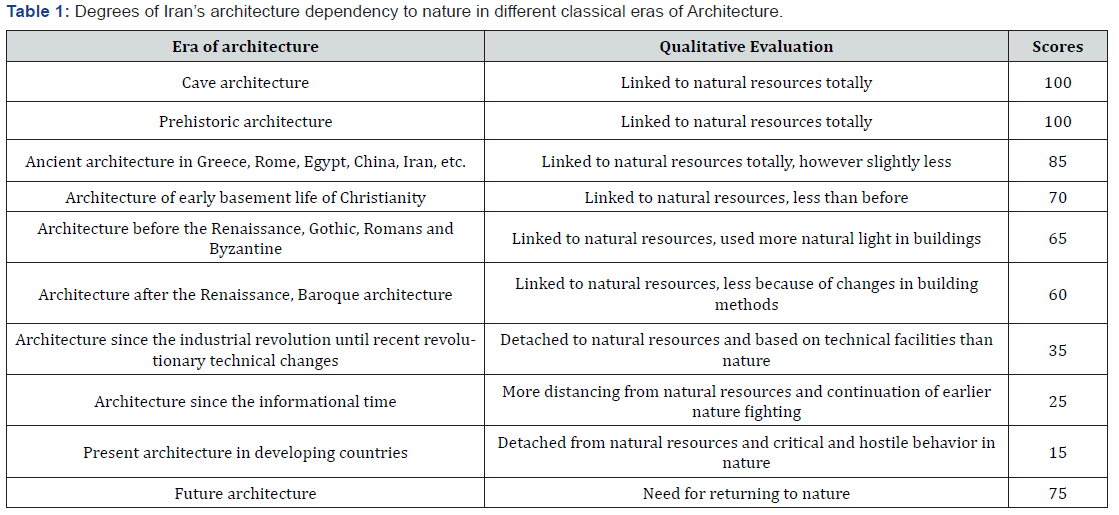
Source: Table 1 is extracted from theoretical and field studies of this paper.
Several scholars also have discussed the energy provision and
looked for a new connection between architecture and nature.
Those ideas, plus consultations with many colleagues, explorations
and experiences assisted the finding of the dependency degree of
Iran’s architecture to nature in the form of numbers. Therefore, the
scores have been decided after enough studies in the architecture
and building style of every era. The scores are within an interval
of the lowest number zero (0) up to the highest number one
hundred (100). On the table, the qualitative evaluations and the
scores report the degree of the architecture’s cohesion with the
natural resources and nature.
Case Studies in Sistan Region
Introduction
The whole region of Sistan is located in Iran, Afghanistan
and Pakistan. The city of Zabol is the largest city of the region
located in Iran. Since Zabol is close to border of three countries,
Iran, Afghanistan, and Pakistan, it has an international position.
Sistan plain is the continuation of Helmand river basin mainly
in Afghanistan. Figure 2 shows the place of Zabol, as the largest
city of Sistan region. Sistan region is an obvious loser of natural
energies while it owns infinite solar and wind resources.

Introducing Sistan’s Ancient Architecture
One of the earliest documented climatic architecture of
ancient time belongs to the Greek philosopher Vitruvius, who
looked at the climate in every building [17,18]. In the Middle East,
ancient architects used local building materials such as clay, sands,
stones, plaster of lime and ashes, and various woods to build their
homes and towns. Mede was an early centralized government in
Iran. The Medes came to Iran in the ninth century BC. The capital
of the Medes was the city of Hamedan in western Iran. Their
dynasty was destroyed by the Persians in 549 BC after about four
centuries [19]. Mede architecture was climatic and popular. Their
architecture had two distinct types namely; Rocky architecture in
the mountainous regions and large cities in the wide plains, such
as the Sistan plain [20,21].
Medes architects built surprisingly solid houses, bridges,
and castles. Basically, they built for normal people unlike to
Achaemenes and Sassanian . Medes promoted public spaces.
Their architectural works were in the form of large buildings on
platforms all over Sistan plain. They built many temples and fire
temples that still are visible. Medes used indigenous materials
and semi-oval arch techniques. They also enjoyed the halls and
porches. Since they used simple building materials such as dried
mud, clay blocks, and wood, their wonderful buildings have been
demolished by passing times [22]. The picture below shows the
building material used by Medes architects in Sistan plain.
In the Sistan plain, you still see Medes building heritage.
Moradgholi describes the importance of the heritage: “Sistan is
a rich collection of historic buildings and archeological sites in
the desert. Through this civilization the missing link between
the civilizations of East and West was found” [23]. Architecture
in Sistan used wide and tall walls with light colors in response to
the hot weather. They designed their homes with cupola roofs and
small openings. Their building materials included sun-dried brick
and cooked bricks. They tried to absorb temperature fluctuations.
One function of the small window was to combat dust and sand
dune storms in the arid regions. The ancient architects arranged
windows to direct the airflow into rooms and to ventilate the air
constantly.
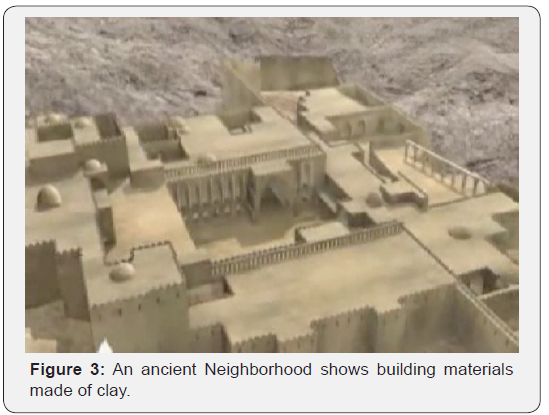
Turner commented that the ventilators moved the air to keep
the inhabitant cool. Other common techniques in the region to
combat the heat were courtyards, patios, and verandas. Oktay
reported more techniques, i.e. high walls and outer spaces (Figure
3). Ancient architects provided shade and a relaxing environment
for the users during social gatherings, evening entertainment, food
preparation, and domestic works such as laundry. A significant characteristic of the ancient building was its functionality. The
people built their homes to satisfy their active life necessities
and their culture and traditions. The homes were affected by
producing, distributing, and consuming activities. In the next
section, some practical features of the ancient Sisan architecture
will be introduced.
Analyzing Functional Characteristics of Sistan Architecture
High compactness of homes: Sistan architecture interacted
well with the climatic hardness. Medes architecture was a unique
instance of ancient knowledge, culture, climate consideration,
and natural energy usage. The old neighborhoods in the region
exhibit also other techniques used in the ancient architecture.
For example, the high compactness of homes and the suitable
localization of buildings as a part of functional plans. Natural
ventilators are used along with applying suitable building
materials too. The architects used buffer and middle spaces and
designed suitable size and place for every opening of a house,
including so-called wind rooms and natural light intakes. A unique
method was the use of plants and vegetation with water. Usually
the ancient architects built homes close together.
One reason was security. Mass homes could be defended
against enemy threats and eventual wild animal attacks. However,
the most significant reason was to protect the buildings against
hot, winds and hard sand dune storms. Figure 4 shows the high
density of the homes in an old district. In the picture, it is visible
that the ancient architects protected the homes from continuous
regional dry windstorms by heaping up of buildings. This
technique had been linked to the livelihood of the people as well
as the defense against the invasion of tribal peoples.
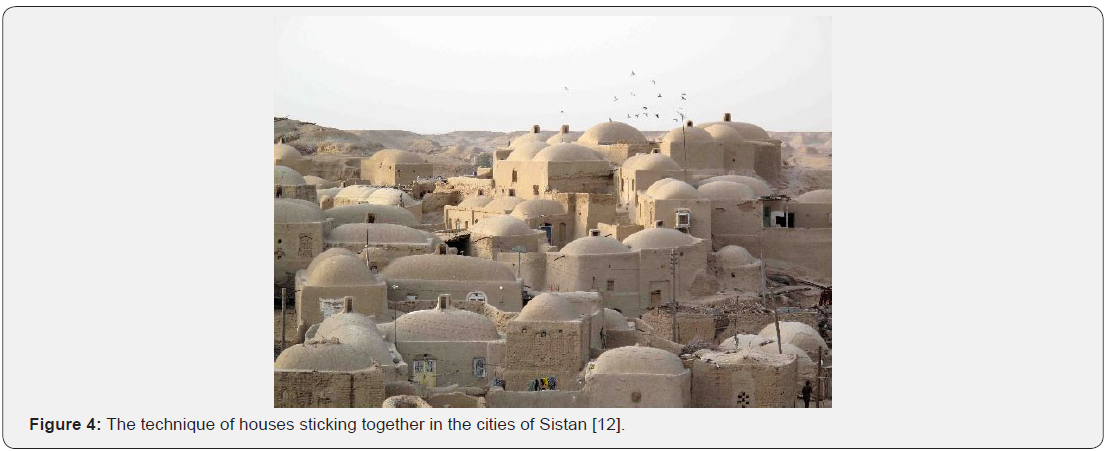
Suitable localization of Buildings: Site planning and placing
of the building in Sistan traditionally depended on factors of hard
winds and sunshine. Kasmaei analyzed the impact of local winds
on the buildings. The arrows in Figure 5 illustrate the behaviors of
local hazardous winds around and through a building. To combat
the winds and climatic hardness ancient architects in Sistan
were building the homes at the northern edge of the site, with a
suitable declination with the north south axis. With the help of
this technique, architects prevented hazardous hot sand dune
storms in the summers and cold weather in the winters.
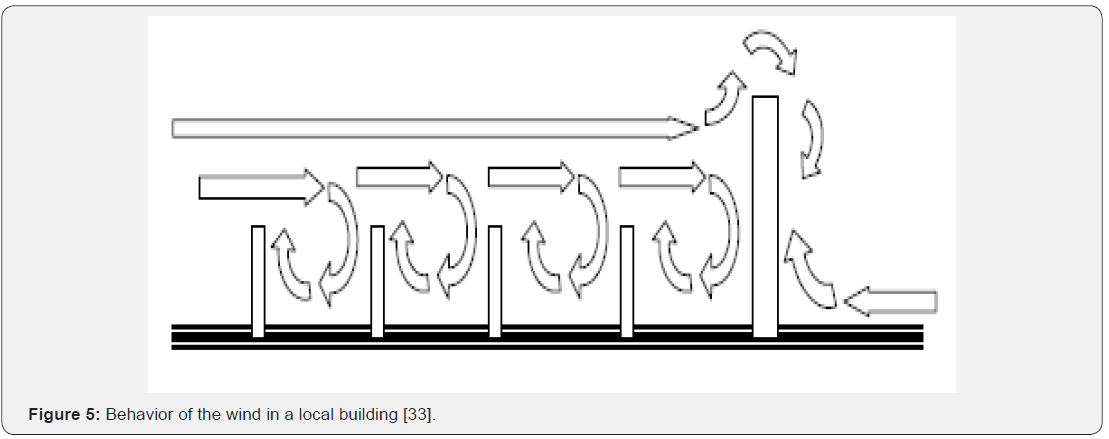
Functional Plans: The ancient building style applied
functional plans based on the livelihood of local people and
the natural environment necessities. The structural plans and
the details arranged the indoor spaces so that they needed less
energy. They placed living rooms and workplaces that required
more warm energy in the south side of the buildings, while they
set the food store on the north side of the building to be colder.
Figure 6 shows a typical plan of an ancient home in the region.

The architects recognized that the shape and form of buildings
are important determinants to consume less energy. They also
understood that the plan must be suitable to the lifestyle of the
regional people and their economic activities.
Natural Moisture Isolation: Clive et al wrote that ancient
architecture had knowledge of niche construction and techniques
to protect the structures by available natural materials. Generally,
organisms directly or indirectly modulate the availability of
resources to other species by causing physical state changes in
biotic materials. In so, ancient engineers modified, maintained,
and created habitats [24]. More than biological techniques they
used natural materials such as natural cement like Sarouj to
isolate the building against water and moisture. They also used
buffer spaces to prevent noise pollution and to create silent rooms
where necessary. They used natural vegetarian poisons against
ants and insects in the wooden elements of the building as well.
Natural Ventilators: Another ancient effective technique in
Sistan ancient buildings was ventilators. Ventilation shifts had
been made in different sizes, shapes, and forms [25]. Fortunately,
many researches, such as Lashkaran, Saidian and Nordquist
performed research related to various uses of wind power in
ancient Sistan [26]. Figure 7 shows one side ventilation shifts on
the roof of every room.
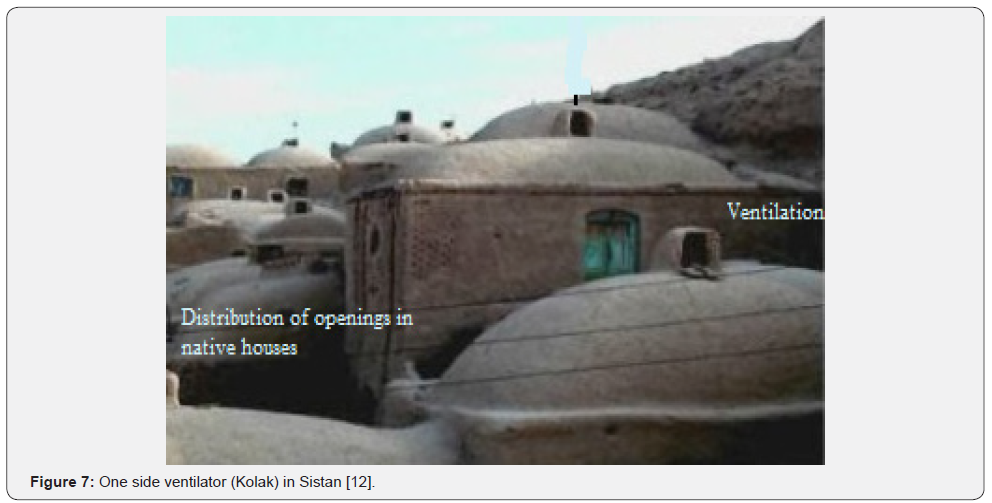
The above photo shows that old Sistan buildings used the
cupola roofs with a small window (Kolak) on the center of the
cupola as a ventilator. The ventilators sucked the air into the
building. Then, the sucked airflow was brought down into the
rooms on the bottom of the house.
Suitable Size and Place for Doors and Windows: Sistan old
houses used small and simple windows at the height of the walls
to transfer outer clean air into the building without heat and dust.
The openers on the tops of walls improve the distribution of the
natural light and cut the direct heat and light, see an illustration of
the technique in Figure 8.
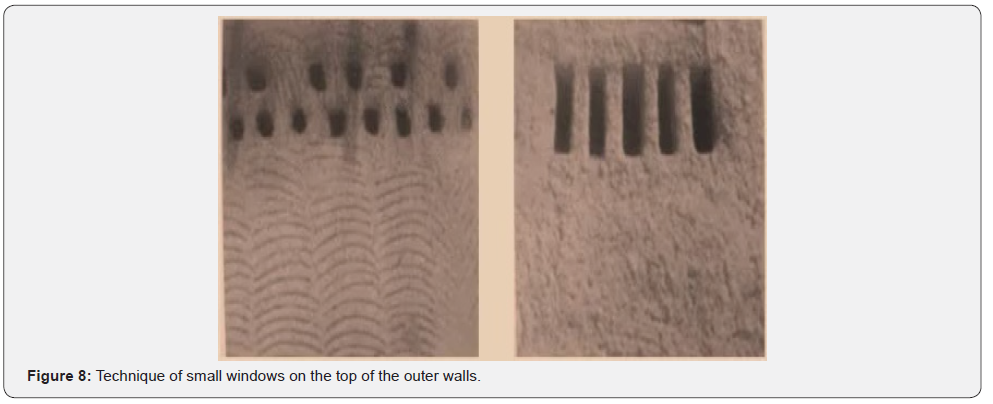
The placing of windows, walls, and circulations of various
indoor spaces with outdoors are significant to reduce energy
consumption. Dwaikat and Ali describe the importance. They
said that to reduce operating energy use we need high-efficiency
windows and insulation in walls, ceilings, and floors. Another
strategy is passive solar building. This is often carried out in lowenergy
homes [27]. Sistan ancient architects implemented what
Dwaikat and Ali recommend.
Using Wind Rooms: Another ancient architectural technique
in the Sistan plain was the wind room. A wind room is an interesting
technique that still exists in other Middle East countries too.
People made it to cool down rooms with the help of local water
and wind. The wind room was at the bottom of the building and
directly under the ventilator (Kolak). The flow of water and wind
went into the wind room and produced a natural desirable clean
cool air. Living rooms and workplaces were around the wind
room and the cool air flowed into them. In fact, the flows of water
and wind passed down into the room and the warm air went up.
Consequently, the air pressure made desirable fresh air with less
moisture in the lower surfaces.
Using Middle Spaces: Traditional homes usually were built
in two stories. The ground floor was for domestic animals like
cows, sheep and horses. The upper floor was for the members of
the family. The homes had a middle space called veranda, which
means “Iwan” in regional language, between the yard and the
building. The middle space or the balcony used to be in the front of
the building called Dakoncha. The wall around the Dakoncha was
about one half meter and a stairway led you to it. The following
picture shows a typical Dakoncha.
Using Natural Light: Ancient architects in Sistan strived
to save energy and use natural light. This study demonstrated
that they placed the Kolak and windows in suitable places and
directions to use natural resources effectively. The Kolak and
windows that have been described earlier had important roles to
use the natural light. The technique of the classic Kolak lighted the
Sistan homes by daily sunshine and the nightly moonlight well.
Applying Suitable Building Materials
Clay is an available building material in Sistan and affected
major forms in the traditional constructions. The building
techniques used the clays as a primitive building material.
Bricklayers compressed solidly molded mud and allowed it
to dry. Tenacious lime mortar also eased the development
and use of brick [28]. Ancient architects supplied the native
building materials and colors in the region. The materials were
harmonized with the climate and the built environment. Givoni
wrote about the building materials as follows: ‘In many arid and
desert regions, buildings are designed with small openings and
heavyweight materials. These materials include dried mud. They
use white or light colors’ [29]. The ancient builders blended straw,
clay mud, and water carefully. Sometimes it took about one month
to give an acceptable mortar by vibrating the materials every day.
Then, they blocked the mortar with a cast in different sizes.
The purpose of the analyzing of the ancient building technology
in Sistan is to encourage the use of ancient experiences combined
with the new technologies to change the current problematic
development trend. The change is necessary to save the natural
resources and environments in the region.
Discussions And Findings
Discussion
Until here, the case study has analyzed the ancient building
techniques in Sistan region. The ancient architects applied those
techniques to build comfort with the help of the natural resources.
Factually, the ancient civilizations had got numerous techniques
and experiences to construct climatic and green. Nevertheless,
this case study studied and only the techniques that are still
observable in the case study region as follows:
a. Building of windmills
b. Building of windbreaks
c. Building of wind rooms
d. Using vegetation and water
e. Design inner, outer and middle spaces
f. Protecting a building thru earth
g. Designing solar walls and windows
h. Making a thermal shell around the building
i. Designing shadows against the sun’s heat
j. Building of natural ventilators
k. Shaping a building by selecting a right place and drawing
up a climatic plan for it
l. Isolating the buildings by natural materials
The main discussion in this paper is that the urban/regional
development shall use natural energies. The hypothesis of this
research is also that the future regional/urban development
should use natural energies to save the natural environmental
components. Like theories of vernacular architecture and eartharchitecture,
the nature-centered architecture saves the natural
resources and solves the existing urban difficulties. Major
scholars, i.e. Jiahua Pan believe that the application of natural
energies requires: First, the preservation of the remaining
natural resources (water, soil and plants) and in the next steps,
improvement of these resources and creating of new resources
[30].
Contemporary buildings do not relay on natural energies
and use mechanical and electrical energies, fossil fuels, etc.,
which damage the environment and nature. At the same time, the
disrespecting of regional difference undermines the uniqueness of
the buildings (Figure 9). The result of this research recommends to
use the ancient experiences, but with new building materials and
new technologies. Today, if architects consider the experiences
of the ancient structural systems with a knowledge-based use
of new building materials and an understanding of the climate
requirements, they will success to build functionally too.

The theories of the scholars and our observation suggest that
natural building is functional, rational, economic, and importantly
savior of various crises. When the regional economy is in troubles,
fossil fuels are limited and energy supplying is costly, a desirable
and economic left alternative is the returning to nature in a
wise and modern way. Therefore, the purpose of this paper is to
see how a modernized version of the ancient building shall be
designed and built in the modern time.
Presenting a Model Based on the Ancient Experiences and new Technologies
With the help of the problem-oriented method the new model
shall address the mentioned urban problems. The model is based
on the vernacular architecture theory too. To design an advanced
version of the Sistan ancient building as a green model the ancient
techniques have been analyzed in this research. The purpose is to
use natural energy and less mechanical and electrical energy with
the help of new knowledge, technologies, and building materials.
A pilot model, as a green building shall reduce the environmental
impact in new urban development projects thru the usage of
natural light, benefiting natural and renewable infinite energies,
and saving the water resources. This model is a new technique in
today’s Sistan region, but the green buildings have been examined
and promoted earlier in other corners of the world.
As an example, nature-based buildings have undergone
breakthroughs in Stockholm and throughout Sweden. Construc tion materials and technologies have developed quickly there.
From an investor’s view the green building has seen as a necessity
[31]. Another sample is the United States of America. There,
the American environmental protection agency promoted green
buildings to reduce the overall impact of Urbanism in the natural
environment and water resources [32]. The above examples give
the lesson that Sistan also has to construct nature-centered. The
examples show that green building is economic. Sistan region is
able to build nature-based buildings too when it has enough natural
resources such as solar energy and winds. Nevertheless, Sistan
shall consider the ancient experiences also apply new knowledge
and technologies from advanced countries.
Sistan shall attract investors for funding the modern naturebased
projects. The project of the nature-based model started
with a site selection technique. As the ancient architects did, the
place of this model has been studied in detail to apply local natural
light and wind. Only after the site observation, a proper place for
the building and its openers could be found and the measures of
the windows could be specified. After the site analysis, a decision
on the form and the shape of the building could be made. Figure
10 shows the ground floor plan of the pilot building.
Figure 10 illustrates the architectural plan of the building in
harmony with daily light aiming to use natural energies. The twostory
model has buffer spaces, rooms for work and production, a
kitchen and stores in its ground floor. The family will live in the
first floor. There are a computer and digital workroom, bedrooms,
a living room, and a bath on the first floor [33,34]. The ventilator
and wind room techniques have been applied in the model too.
Figure 11 shows a linear section of the model. A fountain in the
center of the wind room and windows around it are visible. When
the air flows down on the water makes cool air and inhabitants of
the rooms will enjoy it.

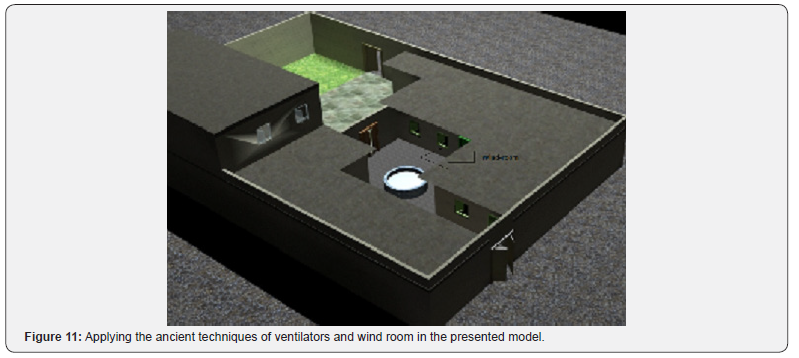
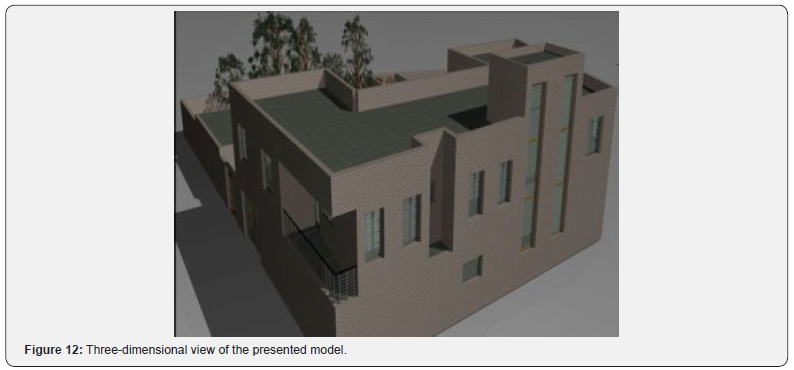
The pilot building model inspired by the Sistan ancient
architecture is a functional home based on the economy and
traditional customs of the region. Following, you see this model
(the modern version of an ancient home) that supplies living and
working spaces for members of a family. The model pays special
attention to building materials to be pertinent to the local climate
and environment as shown in Figure 12. The figure shows how
the ancient techniques have been applied in the model [35,36].
For example, this building reduces the outer openers to suitable
sizes and allows the structure protection against winds and their
negative consequences.
Conclusion
This research followed the method of the past → Present →
future analysis (PPFA) logic. That is why it analyzed Mede’s era,
the current regional/urban crises and the future optimal way. The
advantages of the ancient nature-based Sistan building method
have been reviewed. Then, the discussions were about the ongoing
disappearing of water resources in the arid underdevelopment
countries. This research introduced the present architecture in the
Sistan region as ‘detached from nature’. It argued that the recent
socioeconomic changes, especially the faster population increase
in the region need severe revision in the present architecture and
building style while there is no adequate urban water. In such
a paradoxical situation, the underdevelopment regions should
build climate-adjusted and connected to nature to overcome the
ongoing problems. To check the accuracy of the hypothesis, the
case study of Sistan ancient architecture has been performed. The
study observed directly the advantages and weaknesses of the
ancient building.
The case study was pertinent to the aim of this research owing
to Sistan’s famous ancient heritages that used natural resources
directly and explicitly. Since the socioeconomic situation has
changed dramatically, Sistan needs to plan and design the built
environments based on new realities. The results of this research
will convince architects and entrepreneurs in the region to
change the ongoing problematic trend of the unsustainable, costly
energy consumption and critical urban expansion. Therefore,
a useful recommendation would be to start using the ancient
architectural experiences with the help of advanced knowledge
and technologies. With the help of lessons from Mede architecture,
this paper presented a pilot building model for future homes in
Sistan plain. The model benefits the positive ancient building
techniques related to nature and the environment. From the
other perspective, the presented model uses new knowledge
and information, advanced building technologies, and modern
tolerable building materials. This model is feasible in all desert/
arid/semiarid regions similar to Sistan in the world.
To know more about Journal of Archaeology and Anthropology: https://juniperpublishers.com/gjaa/index.php




Comments
Post a Comment